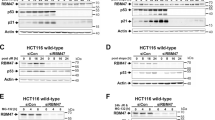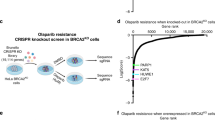Abstract
BRCA1 has been reported to have roles in DNA damage repair, cell cycle checkpoint control, transcriptional regulation and ubiquitination. We have previously demonstrated that BRCA1 is a potent activator of a subset of interferon (IFN)-regulated genes and that BRCA1 synergistically activated a number of these genes in the presence of IFN-γ, but not type I IFNs. Here we report that one of these targets, 2,5 oligoadenylate synthetase (2,5 OAS), is a mediator of BRCA1/IFN-γ-induced apoptosis. We show that the induction of 2,5 OAS in response to IFN-γ is BRCA1 and STAT1 dependent. Consistent with a role as a negative regulator of proliferation, transient transfection of 2,5 OAS into breast cancer cell lines results in decreased colony growth and apoptosis. Furthermore we show that IFN-γ-induced apoptosis is dependent on functional BRCA1 and STAT1 and we demonstrate that IFN-γ-induced apoptosis is dependent on 2,5 OAS induction. 2,5 OAS is the only known upstream regulator of RNaseL, a recently identified hereditary prostate tumour suppressor gene implicated in apoptosis. We propose that BRCA1 may be an upstream regulator of RNaseL, acting in concert with IFN-γ to transcriptionally activate 2,5 OAS, leading to the downstream activation of RNaseL and apoptosis.
This is a preview of subscription content, access via your institution
Access options
Subscribe to this journal
Receive 50 print issues and online access
$259.00 per year
only $5.18 per issue
Buy this article
- Purchase on Springer Link
- Instant access to full article PDF
Prices may be subject to local taxes which are calculated during checkout





Similar content being viewed by others
References
Agrawal S, Agarwal ML, Chatterjee-Kishore M, Stark GR and Chisolm GM . (2002). Mol. Cell. Biol., 22, 1981–1992.
Anderson SF, Schlegel BP, Nakajima T, Wolpin ES and Parvin JD . (1998). Nat. Genet., 19, 254–256.
Andrews HN, Mullan PB, McWilliams S, Sebelova S, Quinn JE, Gilmore PM, McCabe N, Pace A, Koller B, Johnston PG, Haber DA and Harkin DP . (2002). J. Biol. Chem., 277, 26225–26232.
Bhattacharyya A, Ear US, Koller BH, Weichselbaum RR and Bishop DK . (2000). J. Biol. Chem., 275, 23899–23903.
Bochar DA, Wang L, Beniya H, Kinev A, Xue Y, Lane WS, Wang W, Kashanchi F and Shiekhattar R . (2000). Cell, 102, 257–265.
Carpten J, Nupponen N, Izaacs S, Sood R, Robbins C, Xu J, Faruque M, Moses T, Ewing C, Gillanders E, Hu P, Bujnovszky P, Makalowska I, Baffoe-Bonnie A, Faith D, Smith J, Stephan D, Wiley K, Brownstein M, Gildea D, Kelly B, Jenkins R, Hostetter G, Matikainen M, Schleutker J, Klinger K, Connors T, Xiang Y, Wang Z, De Marzo A, Papadopoulos N, Kallioniemi OP, Burk R, Meyers D, Gronberg H, Meltzer P, Silverman R, Bailey-Wilson J, Walsh P, Izaacs W and Trent J . (2002). Nat. Genet., 30, 181–184.
Castelli JC, Hassel BA, Maran A, Paranjape J, Hewitt JA, Li XL, Hsu YT, Silverman RH and Youle RJ . (1998). Cell Death Differ., 5, 313–320.
Gilmore PM, McCabe N, Quinn JE, Kennedy RD, Gorski JJ, Andrews HN, McWilliams S, Carty M, Mullan PB, Duprex WP, Liu ET, Johnston PG and Harkin DP . (2004). Cancer Res., 64, 4148–4154.
Harkin DP, Bean JM, Miklos D, Song YH, Truong VB, Englert C, Christians FC, Ellisen LW, Maheswaran S, Oliner JD and Haber DA . (1999). Cell, 97, 575–586.
Hashizume R, Fukuda M, Maeda I, Nishikawa H, Oyake D, Yabuki Y, Ogata H and Ohta T . (2001). J. Biol. Chem., 276, 14537–14540.
Houvras Y, Benezra M, Zhang H, Manfredi JJ, Weber BL and Licht JD . (2000). J. Biol. Chem., 275, 36230–36237.
Kennedy RD, Quinn JE, Mullan PB, Johnston PG and Harkin DP . (2004). J. Natl. Cancer Inst., 96, 1659–1668.
Lee JS, Collins KM, Brown AL, Lee CH and Chung JH . (2000). Nature, 404, 201–204.
Li H, Lee TH and Avraham H . (2002). J. Biol. Chem., 277, 20965–20973.
MacLachlan TK, Takimoto R and El-Deiry WS . (2002). Mol. Cell. Biol., 22, 4280–4292.
Miki Y, Swensen J, Shattuck-Eidens D, Futreal PA, Harshman K, Tavtigian S, Liu Q, Cochran C, Bennett LM, Ding W, Bell R, Rosenthal J, Hussey C, Tran T, McClure M, Frye C, Hattier T, Phelps R, Haugen-Strano A, Katcher H, Yakumo K, Gholami Z, Shaffer D, Stone S, Bayer S, Wray C, Bodgen R, Dayananth P, Ward J, Tonin P, Narod S, Bristow PK, Norris FH, Helvering L, Morrison P, Rosteck P, Lai M, Barrett JC, Lewis C, Neuhausen S, Cannon-Albright L, Goldgar D, Wisenan R, Kamb A and Skolnick MH . (1994). Science, 266, 66–71.
Moos PJ and Fitzpatrick FA . (1998). Proc. Natl. Acad. Sci. USA, 95, 3896–3901.
Moynahan ME, Cui TY and Jasin M . (2001). Cancer Res., 61, 4842–4850.
Mullan PB, Quinn JE, Gilmore PM, McWilliams S, Andrews H, Gervin C, McCabe N, McKenna S, White P, Song YH, Maheswaran S, Liu E, Haber DA, Johnston PG and Harkin DP . (2001). Oncogene, 20, 6123–6131.
Ouchi T, Lee SW, Ouchi M, Aaronson SA and Horvath CM . (2000). Proc. Natl. Acad. Sci. USA, 97, 5208–5213.
Ouchi T, Monteiro AN, August A, Aaronson SA and Hanafusa H . (1998). Proc. Natl. Acad. Sci. USA, 95, 2302–2306.
Quinn JE, Kennedy RD, Mullan PB, Gilmore PM, Carty M, Johnston PG and Harkin DP . (2003). Cancer Res., 63, 6221–6228.
Rennert H, Bercovich D, Hubert A, Abeliovich D, Rozovsky U, Bar-Shira A, Soloviov S, Schreiber L, Matzkin H, Rennert G, Kadouri L, Peretz T, Yaron Y and Orr-Urtreger A . (2002). Am. J. Hum. Genet., 71, 981–984.
Rokman A, Ikonen T, Seppala EH, Nupponen N, Autio V, Mononen N, Bailey-Wilson J, Trent J, Carpten J, Matikainen MP, Koivisto PA, Tammela TL, Kallioniemi OP and Schleutker J . (2002). Am. J. Hum. Genet., 70, 1299–1304.
Shankaran V, Ikeda H, Bruce AT, White JM, Swanson PE, Old LJ and Schreiber RD . (2001). Nature, 410, 1107–1111.
Shou J, Soriano R, Hayward SW, Cunha GR, Williams PM and Gao WQ . (2002). Proc. Natl. Acad. Sci. USA, 99, 2830–2835.
Silverman RH . (2003). Biochemistry, 42, 1805–1812.
Stark GR, Dower WJ, Schimke RT, Brown RE and Kerr IM . (1979). Nature, 278, 471–473.
Takekawa M and Saito H . (1998). Cell, 95, 521–530.
Thangaraju M, Kaufmann SH and Couch FJ . (2000). J. Biol. Chem., 275, 33487–33496.
Yarden RI and Brody LC . (1999). Proc. Natl. Acad. Sci. USA, 96, 4983–4988.
Zhou A, Paranjape J, Brown TL, Nie H, Naik S, Dong B, Chang A, Trapp B, Fairchild R, Colmenares C and Silverman RH . (1997). EMBO J., 16, 6355–6363.
Acknowledgements
This work was funded by grants from Cancer Research UK, Action Cancer, and the Research and Development Office, Northern Ireland.
Author information
Authors and Affiliations
Corresponding author
Rights and permissions
About this article
Cite this article
Mullan, P., Hosey, A., Buckley, N. et al. The 2,5 oligoadenylate synthetase/RNaseL pathway is a novel effector of BRCA1- and interferon-γ-mediated apoptosis. Oncogene 24, 5492–5501 (2005). https://doi.org/10.1038/sj.onc.1208698
Received:
Revised:
Accepted:
Published:
Issue Date:
DOI: https://doi.org/10.1038/sj.onc.1208698
Keywords
This article is cited by
-
ROGUE: an R Shiny app for RNA sequencing analysis and biomarker discovery
BMC Bioinformatics (2023)
-
Occludin Regulates HIV-1 Infection by Modulation of the Interferon Stimulated OAS Gene Family
Molecular Neurobiology (2023)
-
Human basonuclin 2 up-regulates a cascade set of interferon-stimulated genes with anti-cancerous properties in a lung cancer model
Cancer Cell International (2017)
-
A Modified Coupled Spectrophotometric Method to Detect 2-5 Oligoadenylate Synthetase Activity in Prostate Cell Lines
Biological Procedures Online (2016)
-
Oligoadenylate synthase-like (OASL) proteins: dual functions and associations with diseases
Experimental & Molecular Medicine (2015)



